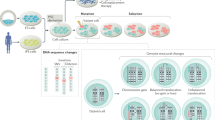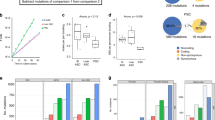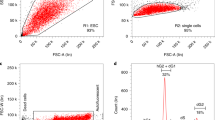Abstract
Cancer stem cells (CSCs) have been implicated in the maintenance and progression of several types of cancer. The origin and cellular properties of human CSCs are poorly characterized. Here we show that CSC-like cells can be generated in vitro by oncogenic reprogramming of human somatic cells during neoplastic transformation. We find that in vitro transformation confers stem-cell properties to primary differentiated fibroblasts, including the ability to self-renew and to differentiate along multiple lineages. Tumours induced by transformed fibroblasts are hierarchically organized, and the cells that act as CSCs to initiate and maintain tumour growth are marked by the stage-specific embryonic antigen SSEA-1. Heterogeneous lineages of cancer cells in the bulk of the tumour arise through differentiation of SSEA-1+ fibroblasts, and differentiation is associated with loss of tumorigenic potential. These findings establish an experimental system to characterize cellular and molecular properties of human CSCs and demonstrate that somatic cells have the potential to de-differentiate and acquire properties of CSCs.
This is a preview of subscription content, access via your institution
Access options
Subscribe to this journal
Receive 12 print issues and online access
$209.00 per year
only $17.42 per issue
Buy this article
- Purchase on Springer Link
- Instant access to full article PDF
Prices may be subject to local taxes which are calculated during checkout








Similar content being viewed by others
References
Reya, T., Morrison, S. J., Clarke, M. F. & Weissman, I. L. Stem cells, cancer, and cancer stem cells. Nature 414, 105–111 (2001).
Clevers, H. The cancer stem cell: premises, promises and challenges. Nat. Med. 17, 313–319 (2011).
Fialkow, P. J., Denman, A. M., Jacobson, R. J. & Lowenthal, M. N. Chronic myelocytic leukemia. Origin of some lymphocytes from leukemic stem cells. J. Clin. Invest. 62, 815–823 (1978).
Perez-Caro, M. et al. Cancer induction by restriction of oncogene expression to the stem cell compartment. EMBO J. 28, 8–20 (2009).
Barker, N. et al. Crypt stem cells as the cells-of-origin of intestinal cancer. Nature 457, 608–611 (2009).
Zhu, L. et al. Prominin 1 marks intestinal stem cells that are susceptible to neoplastic transformation. Nature 457, 603–607 (2009).
Jamieson, C. H. et al. Granulocyte–macrophage progenitors as candidate leukemic stem cells in blast-crisis CML. New Engl. J. Med. 351, 657–667 (2004).
Krivtsov, A. V. et al. Transformation from committed progenitor to leukaemia stem cell initiated by MLL-AF9. Nature 442, 818–822 (2006).
Kleinsmith, L. J. & Pierce, G. B. Jr Multipotentiality of single embryonal carcinoma cells. Cancer Res. 24, 1544–1551 (1964).
Illmensee, K. & Mintz, B. Totipotency and normal differentiation of single teratocarcinoma cells cloned by injection into blastocysts. Proc. Natl Acad. Sci. USA 73, 549–553 (1976).
Lapidot, T. et al. A cell initiating human acute myeloid leukaemia after transplantation into SCID mice. Nature 367, 645–648 (1994).
Al-Hajj, M., Wicha, M. S., Benito-Hernandez, A., Morrison, S. J. & Clarke, M. F. Prospective identification of tumorigenic breast cancer cells. Proc. Natl Acad. Sci. USA 100, 3983–3988 (2003).
Singh, S. K. et al. Identification of a cancer stem cell in human brain tumors. Cancer Res. 63, 5821–5828 (2003).
O’Brien, C. A., Pollett, A., Gallinger, S. & Dick, J. E. A human colon cancer cell capable of initiating tumour growth in immunodeficient mice. Nature 445, 106–110 (2007).
Ricci-Vitiani, L. et al. Identification and expansion of human colon-cancer-initiating cells. Nature 445, 111–115 (2007).
Pece, S. et al. Biological and molecular heterogeneity of breast cancers correlates with their cancer stem cell content. Cell 140, 62–73 (2010).
Son, M. J., Woolard, K., Nam, D. H., Lee, J. & Fine, H. A. SSEA-1 is an enrichment marker for tumor-initiating cells in human glioblastoma. Cell Stem Cell 4, 440–452 (2009).
Hahn, W. C. et al. Creation of human tumour cells with defined genetic elements. Nature 400, 464–468 (1999).
Clarke, M. F. et al. Cancer stem cells—perspectives on current status and future directions: AACR Workshop on Cancer Stem Cells. Cancer Res. 66, 9339–9344 (2006).
Ross, D. D. & Nakanishi, T. Impact of breast cancer resistance protein on cancer treatment outcomes. Methods Mol. Biol. 596, 251–290 (2010).
Thomson, J. A. et al. Embryonic stem cell lines derived from human blastocysts. Science 282, 1145–1147 (1998).
Ward, R. J. et al. Multipotent CD15+ cancer stem cells in patched-1-deficient mouse medulloblastoma. Cancer Res. 69, 4682–4690 (2009).
Read, T. A. et al. Identification of CD15 as a marker for tumor-propagating cells in a mouse model of medulloblastoma. Cancer Cell 15, 135–147 (2009).
Elenbaas, B. et al. Human breast cancer cells generated by oncogenic transformation of primary mammary epithelial cells. Genes Dev. 15, 50–65 (2001).
Neumuller, R. A. & Knoblich, J. A. Dividing cellular asymmetry: asymmetric cell division and its implications for stem cells and cancer. Genes Dev. 23, 2675–2699 (2009).
Cicalese, A. et al. The tumor suppressor p53 regulates polarity of self-renewing divisions in mammary stem cells. Cell 138, 1083–1095 (2009).
Rajasekhar, V. K. Analytical methods for cancer stem cells. Methods Mol. Biol. 407, 83–95 (2007).
Rangarajan, A., Hong, S. J., Gifford, A. & Weinberg, R. A. Species- and celltype-specific requirements for cellular transformation. Cancer Cell 6, 171–183 (2004).
Visvader, J. E. & Lindeman, G. J. Cancer stem cells in solid tumours: accumulating evidence and unresolved questions. Nat. Rev. Cancer 8, 755–768 (2008).
Boiko, A. D. et al. Human melanoma-initiating cells express neural crest nerve growth factor receptor CD271. Nature 466, 133–137 (2010).
Takahashi, K. et al. Induction of pluripotent stem cells from adult human fibroblasts by defined factors. Cell 131, 861–872 (2007).
Hochedlinger, K., Yamada, Y., Beard, C. & Jaenisch, R. Ectopic expression of Oct-4 blocks progenitor-cell differentiation and causes dysplasia in epithelial tissues. Cell 121, 465–477 (2005).
Chen, Y. et al. The molecular mechanism governing the oncogenic potential of SOX2 in breast cancer. J. Biol. Chem. 283, 17969–17978 (2008).
Clark, A. T. The stem cell identity of testicular cancer. Stem Cell Rev. 3, 49–59 (2007).
Wang, J., Xie, L. Y., Allan, S., Beach, D. & Hannon, G. J. Myc activates telomerase. Genes Dev. 12, 1769–1774 (1998).
Wei, D., Kanai, M., Huang, S. & Xie, K. Emerging role of KLF4 in human gastrointestinal cancer. Carcinogenesis 27, 23–31 (2006).
Krizhanovsky, V. & Lowe, S. W. Stem cells: the promises and perils of p53. Nature 460, 1085–1086 (2009).
Corso, C. et al. Molecular cytogenetic insights into the ageing syndrome Hutchinson–Gilford Progeria (HGPS). Cytogenet. Genome Res. 111 (1), 27–33 (2005).
Holliday, D. L., Hughes, S., Shaw, J. A., Walker, R. A. & Jones, J. L. Intrinsic genetic characteristics determine tumor-modifying capacity of fibroblasts: Matrix metalloproteinase-3 5A/5A genotype enhances breast cancer cell invasion. Breast Cancer Res. 9, R67 (2007).
Scaffidi, P. & Misteli, T. Lamin A-dependent misregulation of adult stem cells associated with accelerated ageing. Nat. Cell. Biol. 10, 452–459 (2008).
Scaffidi, P. & Misteli, T. Lamin A-dependent nuclear defects in human aging. Science 312, 1059–1063 (2006).
Scaffidi, P. & Misteli, T. Reversal of the cellular phenotype in the premature aging disease Hutchinson–Gilford progeria syndrome. Nat. Med. 11, 440–445 (2005).
Acknowledgements
We thank J. Lee for instruction in mice injections, K. McKinnon (NCI CCR Vaccine Branch FACS Core Facility) for support with flow cytometry, P. Adams, R. A. Weinberg and L. Li for providing reagents and X. Wu for help with microarray analysis. This research was supported by the Intramural Research Program of the National Institutes of Health (NIH), NCI, Center for Cancer Research.
Author information
Authors and Affiliations
Contributions
P.S. conceived the study and carried out the experimental work. P.S. and T.M. designed the experiments and wrote the manuscript.
Corresponding authors
Ethics declarations
Competing interests
The authors declare no competing financial interests.
Supplementary information
Supplementary Information
Supplementary Information (PDF 1714 kb)
Supplementary Table 1
Supplementary Information (XLSX 37 kb)
Supplementary Table 2
Supplementary Information (XLSX 36 kb)
Supplementary Table 3
Supplementary Information (PDF 353 kb)
Rights and permissions
About this article
Cite this article
Scaffidi, P., Misteli, T. In vitro generation of human cells with cancer stem cell properties. Nat Cell Biol 13, 1051–1061 (2011). https://doi.org/10.1038/ncb2308
Received:
Accepted:
Published:
Issue Date:
DOI: https://doi.org/10.1038/ncb2308
This article is cited by
-
MSL pushes genomic instability over the edge
Nature Cell Biology (2021)
-
Disruption of the MSL complex inhibits tumour maintenance by exacerbating chromosomal instability
Nature Cell Biology (2021)
-
Cells with stemness features are generated from in vitro transformed human fibroblasts
Scientific Reports (2018)
-
Genetic enhancement in cultured human adult stem cells conferred by a single nucleotide recoding
Cell Research (2017)
-
Hepatocellular Carcinoma-propagating Cells are Detectable by Side Population Analysis and Possess an Expression Profile Reflective of a Primitive Origin
Scientific Reports (2016)



